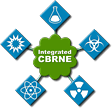 |
 |
 |
 |
|
|
The Department of Homeland Security Directorate of Science and Technology researches and organizes the scientific, engineering and technological resources within the United States. It leverages these tools to protect the homeland. The ICBRNE pilot program was created to move accurate and timely data from the field to locations where it can be analyzed by subject matter experts and appropriate response decisions made. Before the ICBRNE program was created getting accurate information from a confined space was extremely difficult. At the same time Safe Environment Engineering began working with large companies that had more people, more spaces and noisier equipment. Having someone outside to check on the well-being of a person inside was difficult with multiple, loud spaces where it was impossible to hear or see the confined person. Responders wearing heavy suits and face protection often could not read data through the masks. Whatever data they could decipher, could not be broadcast through unreliable and indecipherable audio channels. More than 10 years ago, we began developing the ICBRNE program and system components, the first electronic method that could check on worker well-being using off-the-shelf instruments that were linked through a wireless system. We also sold the product to the Los Angeles Police Department’s hazardous materials team, which was facing similar difficulties. After the terrorist attacks of Sept. 11, 2001, Safe Environment Engineering began partnering with the Department of Homeland Security to create federal interoperability standards, Common Alerting Protocol, and received funding to further develop the ICBRNE program. The Department of Homeland Security then chose Safe Environment Engineering, along with other Southern California partners, to launch the ICBRNE program, further positioning our team as a leader in ensuring our first responders are equipped to keep the American people safe.
|
|
|
Home |
|
About ICBRNE |
|
Documentation |
|
News & Events |
|
ICBRNE Testbed |
|
|
|
|
|
|
|
|
|
|
|
||||
|
|
|
|
|
|
|
|
|
||||
|
|
|
|
|
|
|
|
|
|
|||
|
©Content copyright 2010-2011. All rights reserved. | Web design by IrieLand |
|||||||||||